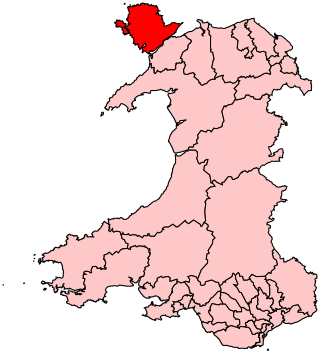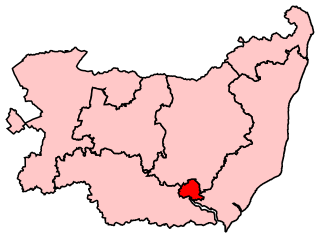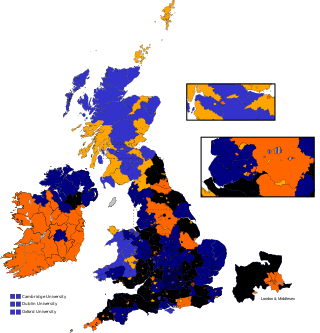
Ynys Môn is a constituency of the House of Commons of the Parliament of the United Kingdom. It elects one Member of Parliament (MP) by the first past the post system of election.

The City of Chester is a constituency represented in the House of Commons of the UK Parliament since 2 December 2022 by Samantha Dixon of the Labour Party. She was elected in the by-election held following the resignation of Chris Matheson MP on 21 October 2022.

Ipswich is a constituency represented in the House of Commons of the UK Parliament since December 2019 by Tom Hunt of the Conservative Party.
Anstruther Burghs was a district of burghs constituency of the House of Commons of the Parliament of Great Britain from 1708 to 1800 and of the House of Commons of the Parliament of the United Kingdom from 1801 to 1832.
Berwickshire was a county constituency of the House of Commons of the Parliament of the United Kingdom from 1708 to 1918, when it was amalgamated with neighbouring Haddington(shire) to form a new Berwick and Haddington constituency.
Haddington Burghs was a Scottish district of burghs constituency of the House of Commons of Great Britain from 1708 to 1801 and of the House of Commons of the United Kingdom from 1801 until 1885. It elected one Member of Parliament (MP) using the first-past-the-post voting system.
Fife was a county constituency represented in the House of Commons of the Parliament of the United Kingdom from 1708 until 1885, when it was divided into East Fife and West Fife.
Aldborough was a parliamentary borough located in the West Riding of Yorkshire, abolished in the Great Reform Act of 1832.
Eye was a parliamentary constituency, represented in the House of Commons of the Parliament of the United Kingdom, encompassing an area around the market town and civil parish of Eye, Suffolk.
Thetford was a constituency of the British House of Commons. It elected two Members of Parliament (MPs) by the bloc vote system of election. It was disenfranchised under the Representation of the People (Scotland) Act 1868, which had resulted in a net increase of seven seats in Scotland, offset by the disenfranchisement of seven English Boroughs.
Bishop's Castle was a borough constituency in Shropshire represented in the House of Commons of the Parliament of the United Kingdom.
Boroughbridge was a parliamentary borough in Yorkshire from 1553 until 1832, when it was abolished under the Great Reform Act. Throughout its existence it was represented by two Members of Parliament in the House of Commons.
Appleby was a parliamentary constituency in the county of Westmorland in England. It existed for two separate periods: from 1295 to 1832, and from 1885 to 1918.
Andover was the name of a constituency of the House of Commons of the Parliament of England from 1295 to 1307, and again from 1586, then of the Parliament of Great Britain from 1707 to 1800 and of the Parliament of the United Kingdom from 1801 to 1918. It was a parliamentary borough in Hampshire, represented by two Members of Parliament until 1868, and by one member from 1868 to 1885. The name was then transferred to a county constituency electing one MP from 1885 until 1918.
Bletchingley was a parliamentary borough in Surrey. It returned two Members of Parliament (MPs) to the House of Commons of England from 1295 to 1707, to the House of Commons of Great Britain from 1707 to 1800, and to the House of Commons of the United Kingdom until 1832, when the constituency was abolished by the Great Reform Act.
Dunwich was a parliamentary borough in Suffolk, one of the most notorious of all the rotten boroughs. It elected two Members of Parliament (MPs) to the House of Commons from 1298 until 1832, when the constituency was abolished by the Great Reform Act.
Flint Boroughs was a parliamentary constituency in north-east Wales which returned one Member of Parliament (MP) to the House of Commons of the Parliament of the United Kingdom and its predecessors, from 1542 until it was abolished for the 1918 general election.

The county constituency of Herefordshire, in the West Midlands of England bordering on Wales, was abolished when the county was divided for parliamentary purposes in 1885. It was a constituency of the House of Commons of the Parliament of England, then of the Parliament of Great Britain from 1707 to 1800 and of the Parliament of the United Kingdom from 1801 to 1885.
Spencer Horsey de Horsey, known until 1832 as Spencer Horsey Kilderbee, was a British Tory politician. He sat in the House of Commons between 1829 and 1841.
William Johnson of Blackwall, Middlesex, and Mandeville's Manor, Sternfield, Aldeburgh, Suffolk, was an English merchant, shipbuilder and Tory politician who sat in the English and British House of Commons for 29 years from 1689 to 1718



